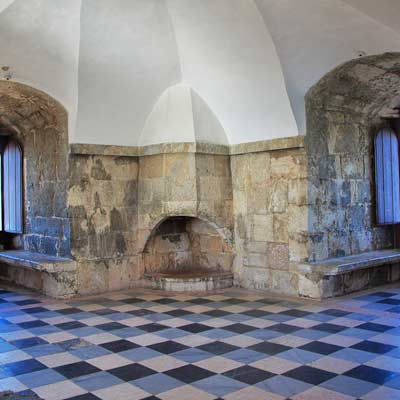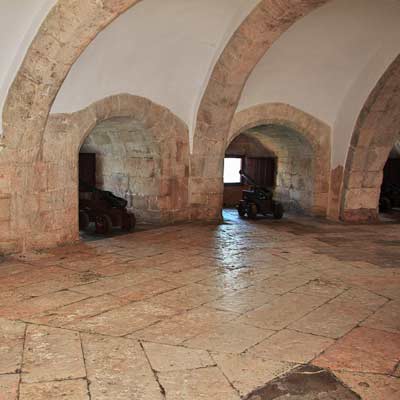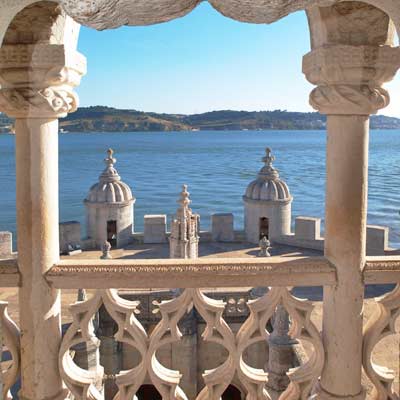LisbonLisboaPortugal.com
The best independent guide to Lisbon
LisbonLisboaPortugal.com
The best independent guide to Lisbon
Torre de Belém, Lisbon; an independent guide to the Belem Tower for 2025
The Torre de Belém is Lisbon's most recognisable monument, a delightful fort that lies at the edge of the Tejo Estuary.
This little fort has guarded the Tejo Estuary since the 16th century and was constructed at the height of the Manueline style of architecture. Decorating the Torre de Belém are Arabic-styled watchtowers, battlements adorned with the "Cross of Christ", and the earliest carving of a rhinoceros in Europe.
Being the iconic monument of Lisbon, the Torre de Belém is always popular with tourists, and there can be very long queues to visit. Inside, the fort is rather empty and austere, especially when compared to the decorative exterior.
The true beauty of the Torre de Belém lies in its highly ornate exterior, featuring intricate stonework and maritime motifs that exemplify Portugal's Manueline era.
This guide will provide you with essential visitor information, tips to beat the crowds, and lesser-known facts about the Torre de Belém to enhance your visit.
Related articles: The Belem district – 2 days in Lisbon
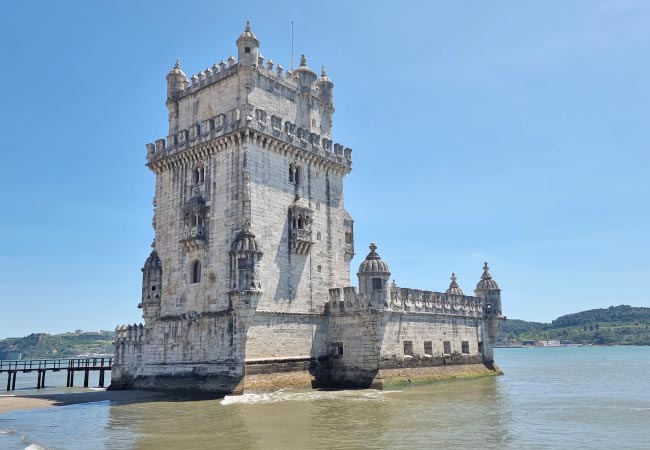
The Torre de Belém at high tide when the sea surrounds the fort
Our opinion: The real attraction of the Torre de Belém is the exterior, while the interior is comparatively sparse. This is one attraction you can forgo entering (and avoid wasting time in queues), instead simply admiring it from the outside where all the intricate stone carvings can be seen. Within the Torre de Belém, there are good views from the top floor, but the views from the Padrão dos Descobrimentos monument are much better.
Tourist Information for the Torre de Belém
The admission to the Torre de Belém costs €8.00 for adults, €4.00 for youth (13-24 years) and seniors (65 years and older), while children 12 and under enter for free.
The monument is open from 9:30 AM to 6:00 PM, with last ticket sales at 5:00 PM and final entry at 5:30 PM. The Torre de Belém is open Tuesday to Sunday but is closed on Mondays. For your trip to the Belém district, it is always best to avoid Mondays when the government-managed tourist attractions will be closed.
The Torre de Belém is a popular tourist attraction and there are often very long queues to enter. These queues are exacerbated as the fort is surprisingly small and only 150 visitors are allowed inside at a time. During the peak season, tickets may be allocated a time slot. When planning your visit, try to arrive as early as possible, as the fort will stay busy until closing time.
Tickets: Belém Tower Entrance Ticket (€8)
A typical visit inside the fort is only 30-40 minutes, and you will probably spend longer queueing than actually inside.
The Torre de Belém is located within the Belém district of Lisbon, at GPS coordinates 38.691, -9.215 (link to Google Maps). The best way to travel to Belém is using the E15 tram, which departs from the Praça Figueira in Baixa. Another option is to catch an Uber or Bolt for the 2.5km, 15-minute drive, which will cost €5-7 depending on demand.
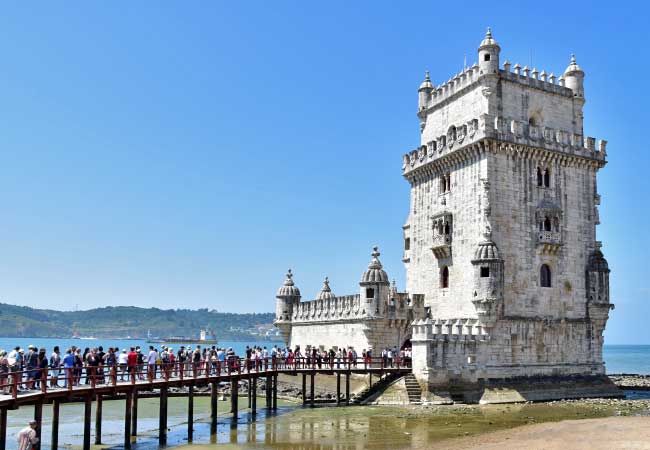
The summertime queues to enter the Torre de Belém
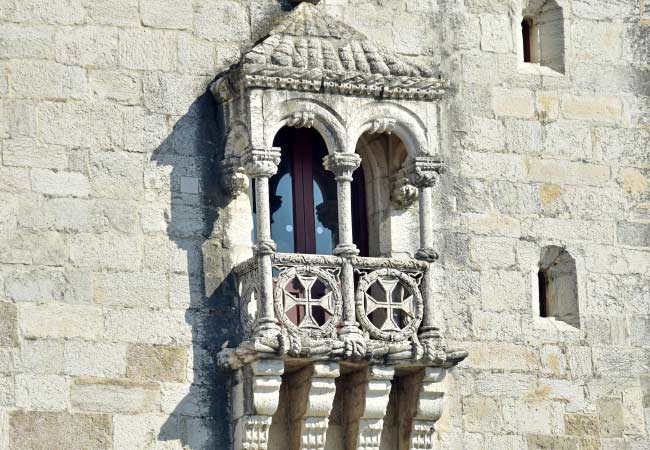
There is beautiful Manueline stone carving through out the Torre de Belém
Inside the Torre de Belém: From Bastions to Turrets
Within the fort, there are two bastion levels and four stories in the tower. The lower bastion level housed the 17 cannons and was later a prison, while the upper bastion is open, being shielded by a low wall. The lower bastion structure closely resembles that of a cloister, with a courtyard area allowing light in and venting cannon smoke.
The floors in the tower are; the Sala do Governador (Governor's Room), the Sala dos Reis (King's Hall), an audience hall, and the chapel and terrace on the top floor. The terrace circles the chapel and offers views over the Tejo Estuary and Belém district. All the floors of the tower are connected by narrow spiral staircases, which can get crowded at peak times.
Historical curiosity: The Torre de Belém was constructed using Lioz limestone blocks, which were surplus and offcuts from the Mosteiro dos Jerónimos that was being constructed at the same time. The Belém Cultural Center (built in 1992) and the Padrão dos Descobrimentos monument (1960) were also constructed using the Lioz limestone so to aesthetically complement the historic monuments of the district.
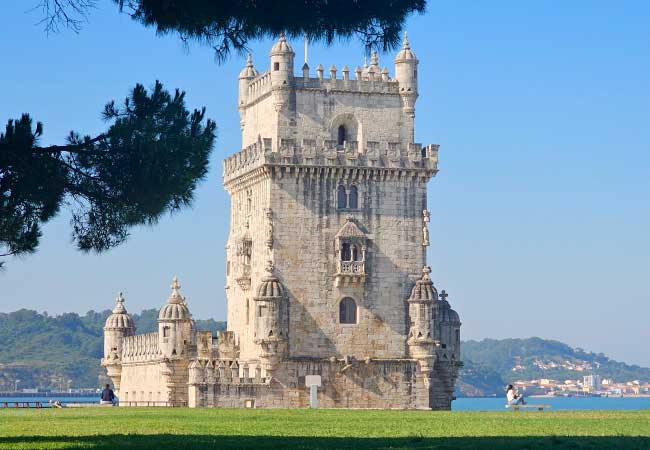
The Torre de Belém lies along the banks of the Tejo Estuary
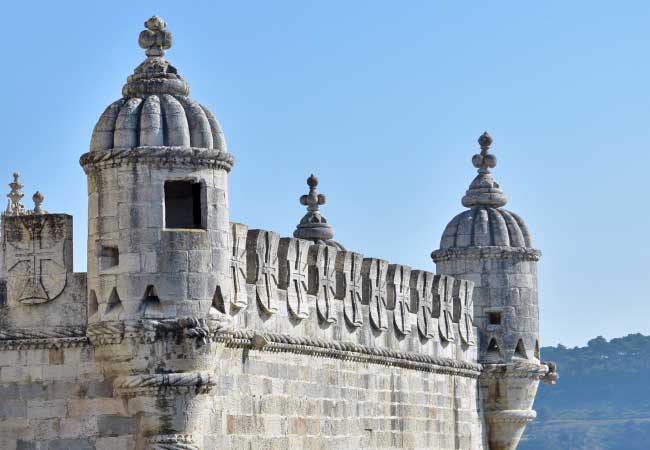
The battlements are lined with the stone carving of the Cross of Order of Christ
How about a small group tour?
One of the best ways to discover Lisbon and meet fellow travellers is to join a guided tour. We have worked with Getyourguide.com for the last seven years, and some of their best tours of Lisbon include:
A quick history of the Torre de Belém
1490 – King João II proposed plans for a set of three fortifications to guard the mouth of the Tejo estuary
1514 – Construction started under the direction of Francisco de Arruda
1519 – Completion of the fort, and dedicated to Saint Vincent, the official name is the Torre de São Vicente
1580 – The tower was defeated by the Spanish navy, leading to Spanish rule of Portugal for 60 years.
1581 – The tower used as a prison
1782 – The Forte do Bom Sucesso was connected to the Torre de Belém
1807 – French forces (under Napoleon's rule) destroyed the upper two stories to create a wooden defensive structure.
1831 – Battle of the Tejo: A naval engagement during Portugal's Liberal Wars. 1845 – The upper stories were restored
1865 – The tower was used as a lighthouse

The elephant vs rhinoceros at the Torre de Belém
During the 16th century era of discovery and seafaring, the Portuguese encountered many new wondrous sights and treasures. One of the strangest events was held in 1517 at the beach close to the Torre de Belém (where the Praça do Império is today) and tried to determine which of the newly "discovered" animals from Africa and Asia was the mightiest. This pitted an Asian Elephant against an African Rhinoceros, both gifts to King Manuel from the Sultan of Gujarat.
The actual fight was a disappointment for the expecting crowd and King, as when the Elephant saw the Rhinoceros, it turned and fled. The Rhino's victory was commemorated with a carving on the Torre de Belém. Sadly, the Rhino, known as Ganda, drowned in a shipwreck while being transported to Pope Leo X.
Insight: The small stone rhinoceros carving is on the exterior of the western tower, but the carving has been severely worn over the centuries.
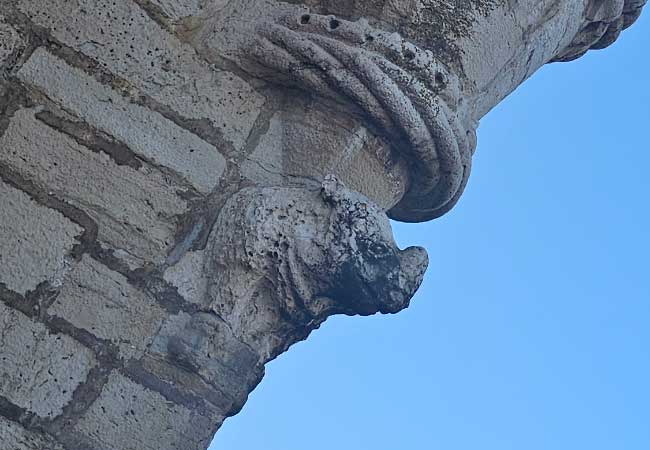
The small statue of the rhinoceros on the western tower

The Rhino statue is at the bottom of the watch tower, and is circled
Careful, the King can hear you...
Torre de Belém as a fort
The Belém Tower was constructed to protect the shipyards at Restelo, which during the late 15th and early 16th century were the centre of shipbuilding in Portugal. These shipyards were vulnerable to seaward attack, being close to the mouth of the Tejo estuary and 2.5km from Lisbon's defences.
King João II proposed the construction of a line of defences of three forts; one on the north banks, one on the south and one on the rocky outcrop in the middle of the Tejo. The landside forts were the priority for King João and the construction of the Torre de Belém was delayed until the reign of his son Manuel I.
At the time of construction (1514), the rocky outcrop on which the Torre de Belém sits was approximately 180m from the shoreline. The finished tower was installed with 17 cannons, and was one of the first Portuguese defensive structures to be designed to withstand an artillery barrage.
These defences were not strong enough to withstand the attack by the Spanish navy in 1580, and surrendered in only four hours. This defeat led to the Spanish claiming the Portuguese throne for over 60 years. The Spanish were not impressed by the Torre de Belém and used it only as a lowly political prison.
The unfortunate prisoners of the Torre de Belém
The lower level of the Torre de Belém was originally constructed for the cannons and as a store for weapons and food. As the priorities of the fort altered, this lower level became a convenient location to hold political prisoners.
This was an unfortunate location to be imprisoned, as the lower floor was susceptible to constant flooding either from high tides or storms. Routinely, the prisoners would be in water up to waist height...
Sights near the Torre de Belém
Mosteiro dos Jerónimos
This UNESCO World Heritage site is a masterpiece of Manueline architecture. Commissioned by King Manuel I in 1501, this monastery is a testament to Portugal's wealth during the Age of Discovery, and took over 100 years to complete. Inside, you'll find the tomb of Vasco da Gama and an impressively ornate two-story cloister - read our guide to the Mosteiro dos Jerónimos.
Padrão dos Descobrimentos
Standing proudly on the banks of the Tejo, this 52m-high monument pays homage to Portugal's Age of Discovery. Shaped like a caravel's prow, it features statues of explorers, cartographers, and royalty. Don't miss the chance to ascend to the top for panoramic views of Belém and the river - our guide to the Padrão dos Descobrimentos.
Museu Nacional dos Coches
Home to one of the world's finest collections of historical carriages, this museum offers a unique glimpse into the transport of Portugal's past. From ornate royal coaches to everyday 19th-century carriages, the exhibits showcase the evolution of horse-drawn transportation.
Pastéis de Belém
No visit to Belém is complete without sampling the famous pastéis de nata at this historic bakery. Operating since 1837, it guards the original recipe of these delicious custard tarts.
Museu de Arte, Arquitetura e Tecnologia (MAAT)
This striking contemporary museum, opened in 2016, is hard to miss with its wave-like structure. MAAT hosts a rotating series of exhibitions focusing on contemporary art, architecture, and technology. Its rooftop offers another excellent viewpoint over the Tejo
Discover more of Lisbon with our most popular guides
If you've found our content valuable, we'd welcome your support.
The digital publishing landscape has evolved significantly. As a small independent publisher, we face growing challenges. Search engines increasingly favour paid content over organic results, while AI-generated content often reproduces original work without attribution.
To support our work, please consider bookmarking this page (press Ctrl + D) for quick access. If you find an article helpful, we'd be grateful if you'd share it with friends on social media.
For specific questions, please see our Reddit community at r/LisbonPortugalTravel.
Should you notice any outdated or incorrect information, please contact us at [email protected]
Thank you for helping us continue to provide valuable content in an increasingly challenging digital environment.
A complete list of all of our Lisbon articles
If you've found our content valuable, we'd welcome your support.
The digital publishing landscape has evolved significantly. As a small independent publisher, we face growing challenges. Search engines increasingly favour paid content over organic results, while AI-generated content often reproduces original work without attribution.
To support our work, please consider bookmarking this page (press Ctrl + D) for quick access. If you find an article helpful, we'd be grateful if you'd share it with friends on social media.
For specific questions, please see our Reddit community at r/LisbonPortugalTravel.
Should you notice any outdated or incorrect information, please contact us at [email protected]
Thank you for helping us continue to provide valuable content in an increasingly challenging digital environment.
